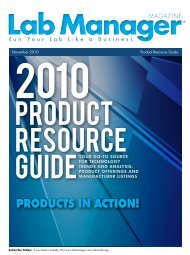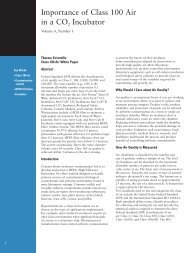lab manager's independent guide to purchasing particle analysis ...
lab manager's independent guide to purchasing particle analysis ...
lab manager's independent guide to purchasing particle analysis ...
You also want an ePaper? Increase the reach of your titles
YUMPU automatically turns print PDFs into web optimized ePapers that Google loves.
Lab Manager's Independent Guide <strong>to</strong> Purchasing Particle Analysis/Particle Characterization Instruments<br />
November 2011 Copyright © <strong>lab</strong> manager magazine®<br />
Acoustic spectroscopy<br />
Acoustic spectroscopy is useful if both <strong>particle</strong> size and zeta-potential need <strong>to</strong> be investigated.<br />
Acoustic spectroscopy measures the attenuation and sound speed of ultrasound pulses as they pass through<br />
concentrated slurries. The measurements are made over a wide range of frequencies and the resulting spectra<br />
are used <strong>to</strong> calculate the <strong>particle</strong> size distribution over a range from 10 nanometers <strong>to</strong> more than 10 micrometers.<br />
Horiba<br />
DT-1201<br />
Matec<br />
APS-100<br />
Matec<br />
Zeta-APS<br />
Light scattering<br />
Dispersion Technology<br />
DT-100<br />
Matec<br />
zetafinder<br />
Particle Sizing Systems<br />
380ZLS<br />
Dispersion Technology<br />
DT-300<br />
Matec<br />
ZA500<br />
Light scattering is a popular technique for determining <strong>particle</strong> size. Dynamic light scattering can be used <strong>to</strong><br />
measure smaller <strong>particle</strong>s (less than a few microns) than is possible using static light scattering techniques.<br />
A Dynamic<br />
Dynamic light scattering works by observing the Doppler shift of the incident light due <strong>to</strong> the<br />
Brownian motion of the suspended particulates. When a coherent light source shines on these <strong>particle</strong>s,<br />
light will be scattered from the <strong>particle</strong>s, but the frequency will be shifted because the <strong>particle</strong>s are in<br />
motion (Doppler shift). The speed of the <strong>particle</strong>s determines how much the frequency is shifted.<br />
Micromeritics<br />
Vasco DLS<br />
Brookhaven Instruments<br />
90Plus<br />
Brookhaven Instruments<br />
NanoDLS<br />
Wyatt Technology<br />
WyattQELS<br />
Dantec Dynamics<br />
FiberPDA system<br />
Brookhaven Instruments<br />
BI-MwA<br />
Wyatt Technology<br />
MiniDawn Treos<br />
Kunash<br />
Saturn Digisizer 5205<br />
Brookhaven Instruments<br />
FOQELS<br />
Brookhaven Instruments<br />
BioDLS<br />
Wyatt Technology<br />
Dynapro Plate Reader<br />
Dantec Dynamics<br />
DualPDA<br />
Brookhaven Instruments<br />
BI-200SM<br />
AIM<br />
AS-2012<br />
Brookhaven Instruments<br />
BI-200SM<br />
Brookhaven Instruments<br />
ACOS<br />
Wyatt Technology<br />
Dynapro Nanostar<br />
Dantec Dynamics<br />
PDA HiDense<br />
B Static<br />
Modern static light scattering instruments have become the method of choice in most<br />
industries due <strong>to</strong> their <strong>analysis</strong> speed, wide size range, ease of use, flexibility, and reproducibility.<br />
Static light scattering measures <strong>particle</strong> size by scattering light from the edge of the <strong>particle</strong> at an<br />
angle which is dependent on the size of the <strong>particle</strong>. Larger <strong>particle</strong>s scatter light at relatively smaller<br />
angles than light scattered from smaller <strong>particle</strong>s. From observing the intensity of light scattered at<br />
different angles, it is possible <strong>to</strong> determine the relative amounts of different sized <strong>particle</strong>s.<br />
AIM<br />
AS-2011<br />
Microtrac<br />
Bluewave<br />
Wyatt Technology<br />
Dawn Heleos II<br />
Microtrac<br />
S3500<br />
Particle size characterization<br />
Accurate <strong>particle</strong> size characterization is essential in many processes in a large number<br />
of industries and research areas, including pharmacology, cosmetics, nanotechnology,<br />
paints, pigments, food science, ceramics, textiles, geological science, polymer science,<br />
environmental science, catalysis and powder metallurgical science.<br />
The term “<strong>particle</strong> size characterization” can be used <strong>to</strong> cover size measurement only,<br />
or any combination of size, shape, zeta potential, surface area and other parameters.<br />
A wide range of instruments is avai<strong>lab</strong>le <strong>to</strong> facilitate <strong>particle</strong> size characterization and<br />
tailored according <strong>to</strong> individual needs and requirements.<br />
This <strong>purchasing</strong> <strong>guide</strong> attempts <strong>to</strong> simplify the range of avai<strong>lab</strong>le <strong>particle</strong><br />
characterization instruments by categorizing them according <strong>to</strong> type and function.<br />
Surface area spectroscopy<br />
Surface area spectroscopy determines the way a solid<br />
interacts with its surroundings, and is the most widely used<br />
means of characterizing porous materials. Since the surface<br />
area corresponds <strong>to</strong> the roughness of the <strong>particle</strong> exterior<br />
and its porous interior, gas sorption is the preferred technique<br />
<strong>to</strong> measure <strong>particle</strong> surface area.<br />
Micromeritics<br />
SMS Surface Energy Analyzer<br />
Kunash<br />
Tristar 3020<br />
Kunash<br />
ASAP 2420<br />
Kunash<br />
ASAP 2050<br />
Quantachrome Instruments<br />
IQ Series<br />
Kunash<br />
Gemini 2390<br />
Kunash<br />
ASAP 2020<br />
Kunash<br />
Flowsorb III<br />
Merrow Scientific<br />
BELSORP<br />
AIM<br />
AS-3012<br />
Image <strong>analysis</strong><br />
Image <strong>analysis</strong> is becoming an increasingly popular <strong>to</strong>ol for <strong>particle</strong> size and shape <strong>analysis</strong> of powders. Modern image<br />
<strong>analysis</strong> systems for <strong>particle</strong> characterization are capable of analyzing tens of thousands of <strong>particle</strong>s in a matter of minutes with<br />
sensitivity down <strong>to</strong> below 1 µm.<br />
Image <strong>analysis</strong> can be dynamic or static, both of which are used in many industrial applications.<br />
A Dynamic<br />
In dynamic image <strong>analysis</strong>, <strong>particle</strong>s flow past one or more<br />
cameras. Dynamic image <strong>analysis</strong> generally has lower sensitivity<br />
than static systems.<br />
Horiba<br />
CAMSIZER<br />
Micrometrics<br />
Particle Insight<br />
Spectro<br />
SpectroNF Q200<br />
Horiba<br />
CAMSIZER-XT<br />
Clemex<br />
PSA<br />
START<br />
HERE<br />
Introduction:<br />
Particle size characterization<br />
The accurate measurement of <strong>particle</strong> characteristics is essential in many industrial and research processes. A large<br />
number of <strong>particle</strong> characterization instruments are avai<strong>lab</strong>le, offering a wide range of options and functions. It is<br />
important <strong>to</strong> select the appropriate instrument for your specific needs in order <strong>to</strong> ensure optimal results.<br />
When <strong>purchasing</strong> a <strong>particle</strong> characterization instrument the first consideration should be what characteristics need<br />
<strong>to</strong> be measured. Laser diffraction instruments are widely used for size measurements only, image <strong>analysis</strong> instruments<br />
tend <strong>to</strong> be used for size and shape data, while acoustic spectroscopy instruments can be used <strong>to</strong> measure both size<br />
and zeta potential.<br />
B Static<br />
In static image <strong>analysis</strong>, <strong>particle</strong>s sit on a slide moved by an<br />
au<strong>to</strong>mated stage for inspection by camera and microscope. Static<br />
image <strong>analysis</strong> systems provide greater sensitivity and operate on<br />
more sophisticated software for more complex investigations.<br />
Horiba<br />
PSA300<br />
Sympatec<br />
PICTOS<br />
Malvern<br />
Sysmex FPIA-3000<br />
Sympatec<br />
PICTIS<br />
Nano<strong>particle</strong> characterization<br />
The emergence and rapid evolution of the field of nanotechnology has created a requirement for<br />
<strong>particle</strong> characterization instruments capable of measuring <strong>particle</strong> sizes on the nanometer scale.<br />
Considerable effort has been devoted <strong>to</strong> developing instruments capable of measuring smaller<br />
and smaller <strong>particle</strong>s, and a number of these are able <strong>to</strong> measure <strong>particle</strong>s only nanometers in size.<br />
Horiba<br />
SZ-100<br />
Brookhaven Instruments<br />
ZetaPALS<br />
Brookhaven Instruments<br />
ACOS<br />
Brookhaven Instruments<br />
BI-XDC<br />
IZON<br />
qNano<br />
Nanosight<br />
NS200<br />
Bettersize Instruments<br />
BT-90<br />
Beckman Coulter<br />
Delsa Nano C<br />
Beckman Coulter<br />
Delsa Nano Z<br />
Brookhaven Instruments<br />
90Plus<br />
Brookhaven Instruments<br />
FOQELS<br />
Brookhaven Instruments<br />
NanoDLS<br />
Brookhaven Instruments<br />
BI-DCP<br />
Nanosight<br />
LM10<br />
Nanosight<br />
NS500<br />
Fritsch<br />
Nanotec Plus<br />
Beckman Coulter<br />
Delsa Nano S<br />
Particle Sizing Systems<br />
Nicomp 380<br />
Brookhaven Instruments<br />
ZetaPlus<br />
Brookhaven Instruments<br />
BI-200SM<br />
Brookhaven Instruments<br />
BioDLS<br />
TSI<br />
3936<br />
Nanosight<br />
LM20<br />
Microtrac<br />
Nanotrac Wave<br />
Fritsch<br />
12 DynaSizer<br />
Beckman Coulter<br />
Delsa Nano HC<br />
Laser diffraction<br />
Laser diffraction can be used for the non-destructive <strong>analysis</strong> of wet or dry samples, with <strong>particle</strong>s<br />
in the size range of 0.02 <strong>to</strong> 2000 microns, and has inherent advantages that make it preferable <strong>to</strong><br />
other options for many different materials.<br />
Laser diffraction techniques are useful if only the <strong>particle</strong> size needs <strong>to</strong> be investigated.<br />
A<br />
Portable systems<br />
Portable <strong>particle</strong> characterization instruments are useful when bench space is limited; offering<br />
efficient use of bench space, while preserving accuracy, precision, and resolution.<br />
B<br />
C<br />
Horiba<br />
LA-300<br />
Malvern<br />
Mastersizer micro<br />
Standard systems<br />
Standard systems are the mainstay of laser diffraction for the measurement of <strong>particle</strong> size.<br />
Horiba<br />
LA-950<br />
Malvern<br />
Insitec<br />
Cilas<br />
CILAS 1190<br />
Bettersize Instruments<br />
9300ST<br />
Bettersize Instruments<br />
2002<br />
Fritsch<br />
MicroTec Plus<br />
Beckman Coulter<br />
LS 200<br />
Spray droplet size systems<br />
Measurement of droplet characterization in sprays and aerosols relies on a specific form<br />
of laser diffraction requiring dedicated instrumentation.<br />
Malvern<br />
Spraytec<br />
Oxford Lasers<br />
VisiSizer D30<br />
Dantec Dynamics<br />
IPI<br />
Malvern<br />
Mastersizer 2000<br />
Cilas<br />
CILAS 990<br />
Bettersize Instruments<br />
2000<br />
Bettersize Instruments<br />
9300S<br />
Bettersize Instruments<br />
2003<br />
Beckman Coulter<br />
LS 13 320 MW<br />
Particle Sizing Systems<br />
AccuSizer 780AD<br />
MicroTrac<br />
Aerotrac<br />
Oxford Lasers<br />
VisiSizer portable<br />
Particle Sizing Systems<br />
Accusizer 780 APS<br />
Malvern<br />
Mastersizer 2000E<br />
Cilas<br />
CILAS 1090<br />
Bettersize Instruments<br />
9300Z<br />
Bettersize Instruments<br />
2001<br />
Sympatec<br />
Helox<br />
Beckman Coulter<br />
LS 13 320 SW<br />
MicroTrac<br />
DIA<br />
Oxford Lasers<br />
VisiSizer S200<br />
Author: John Buie
Particle<br />
Analysis/<br />
Particle<br />
Characterization<br />
Instruments<br />
LAB MANAGER<br />
MAGAZINE’S<br />
INDEPENDENT<br />
GUIDE TO<br />
PURCHASING<br />
Particle Analysis/<br />
Particle Characterization<br />
Instruments<br />
www.<strong>lab</strong>manager.com<br />
BUY & SELL EQUIPMENT • ONLINE AUCTIONS<br />
NEW PRODUCT INTRODUCTIONS • GREAT DEALS<br />
Register <strong>to</strong>day <strong>to</strong> run ads, bid in LabAuctions, or contact buyers and sellers. LabX<br />
showcases over 190,000 listings of new, surplus and pre-owned <strong>lab</strong> equipment and<br />
supplies. Visit LabX <strong>to</strong>day and get the product you’ve always wanted NOW!<br />
WWW.LABX.COM










